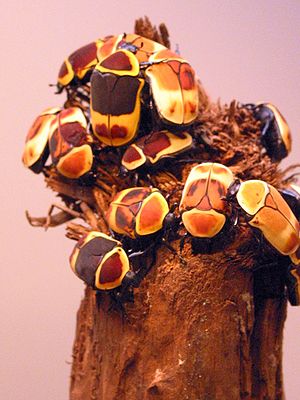Congo rose beetle
| Congo rose beetle | ||||||||||||
|---|---|---|---|---|---|---|---|---|---|---|---|---|

Congo rose beetle ( Pachnoda marginata peregrina ) |
||||||||||||
| Systematics | ||||||||||||
|
||||||||||||
| Scientific name | ||||||||||||
| Pachnoda marginata | ||||||||||||
| ( Drury , 1773) |
The Congo rose beetle ( Pachnoda marginata ) is a beetle from the subfamily of the rose beetles (Cetoniinae).
features
The beetle reaches a length of 20 to 25 millimeters. A sure sign of distinguishing between the sexes is the longitudinal furrow present on the underside of the male's abdomen. The belly side, as well as the head and legs are always colored black-brown. The entire upper side is matt velvety and can vary greatly in color depending on the subspecies . In the following, the best-known subspecies are presented and their back coloring is described:
-
Pachnoda marginata aurantia Herbst , 1790
is completely orange-yellow with a light yellow border.
-
Pachnoda marginata marginata ( Drury , 1773)
is red-brown with a thin, yellow band running circularly around the elytra and the anterior pronotum.
-
Pachnoda marginata peregrina Kolbe , 1906
the best-known subspecies, is also red-brown with a bright yellow, broader band around the entire pronotum and the outer edges of the elytra. Its rear third is completely yellow apart from two red-brown spots that can be connected to one another.
Occurrence
As the name suggests, the species is primarily native to the Congo . But different subspecies can also be found in other areas of Central and West Africa, such as Guinea , Senegal , Angola , Cameroon , Kenya and Sudan .
Way of life
The flyable imagos facilitate their Usage Rate occasionally in that they rotate about their own axis while they spread their wings under the deck wings brought. They live mainly on trees and bushes and feed on fruits, petals and tree sap. The beetles can also be found on the ground. Mating also takes place on trees and shrubs or the ground. In the absence of females, group pairings can be observed between the males, in which up to four beetles can sit on top of each other. The larva ( grubs ) lives in the ground and feeds on fallen leaves and fruits, which they nibble from below while lying on their back. A female can live around seven months and the male around five months.
Reproduction
The development from egg to adult beetle is completed after about five months. The up to 178 eggs are laid in the ground by the female. The larva hatches after three to four weeks. It pupates after about three months in a self-made cocoon made of grains of earth and a special body secretion, which is usually attached to larger solid parts in the soil such as roots (in the terrarium also on the terrarium wall). The beetle hatches after another five to eight weeks and leaves the cocoon a few days later, when the chitin shell is completely hardened and colored, and digs out of the earth.
Systematics
The nominate form of the Congo rose beetle was originally described by Dru Drury under the name Scarabaeus marginatus . Today different subspecies are differentiated, of which the subspecies Pachnoda marginata peregrina has been described under several names that are meanwhile synonymous , of which especially the first mentioned here is often used incorrectly even today.
The following subspecies are listed:
- Pachnoda marginata marginata ( Drury , 1773)
- Pachnoda marginata aurantia autumn , 1790
- Pachnoda marginata cerandi Rigout , 1984
- Pachnoda marginata fernandezi Rigout , 1984
- Pachnoda marginata mirei Ruter , 1963
- Pachnoda marginata murielei Rigout , 1986
- Pachnoda marginata peregrina Kolbe , 1906
- Syn. = Pachnoda butana Schurhoff , 1938
- Syn. = Pachnoda bipartita Schurhoff , 1938
- Syn. = Pachnoda erythraena Schurhoff , 1938
- Syn. = Pachnoda negi Schurhoff , 1938
- Syn. = Pachnoda zonaria Bourgoin , 1919
- Pachnoda marginata tunisiensis Rigout , 1984
Terrariums
This type of beetle is often kept in the terrarium by lovers and is considered to be easy to multiply. They are fed with sliced bananas, which are exchanged twice a week to prevent fruit flies from multiplying too quickly. A slightly damp but never wet mixture of sand and potting soil is used as a substrate for laying eggs and for the development of the grubs, to which white rotting wood of oak , beech , maple or linden should be added. The development time is strongly dependent on the temperature, which should be between 23 and 30 ° C. Because it is easy to keep and easy to breed, another area of application in terraristics has developed: The larvae of this species are often offered as live food for large reptiles.
photos
Individual evidence
- ↑ a b www.flower-beetles.com - engl. Rose beetle page
- ↑ a b c Arndt Löwenberg: Exotic beetles, care and breeding of rose and giant beetles in the terrarium . bede, Ruhmannsfelden 1999. ISBN 3-933646-44-8
- ^ H. Guyot: L'élevage des Cétoines you like Pachnoda . Ed. OPIE-Insectes 83 (4), 11-14, 1991.
- ↑ www.hier-krabbelts.de ( Memento from June 20, 2008 in the Internet Archive ) - Catalog of African rose beetles








